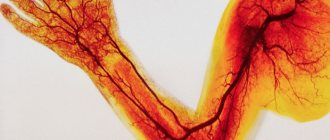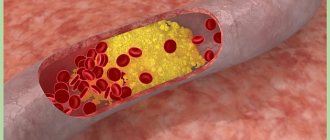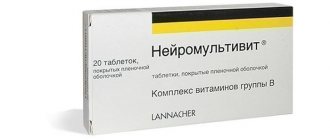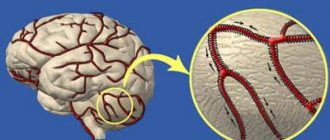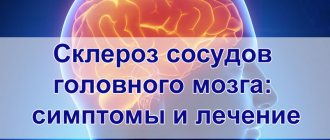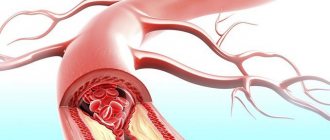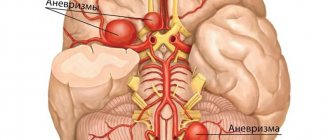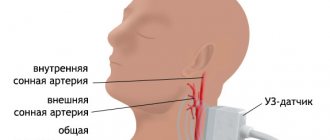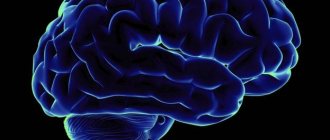Atherosclerosis is a disease that requires complex treatment. Non-drug and drug therapy methods are used. How to treat cerebral atherosclerosis with medications? For this purpose, several pharmacological groups are used to help eliminate pathogenetic mechanisms and main symptoms.
The essence of atherosclerotic changes is the accumulation of fatty molecules in the vascular endothelium. The result is the formation of a cholesterol plaque, which impedes blood flow. This leads to disruption of the blood supply to one or another organ. If the lumen of the vessel is blocked by more than 80%, the risk of strokes and heart attacks is high. Drug treatment is the first step in eliminating atherosclerotic changes.
Development of atherosclerosis
The development of atherosclerosis begins from the human circulatory system. In a healthy person, blood, circulating in the blood vessels, delivers oxygen and nutrients to all organs and tissues. With a normal diet, cholesterol is also present in the blood.
Cholesterol is an organic compound, a natural fatty (lipophilic) alcohol that is found in the cell membranes of the body. Cholesterol plays an important role in protecting cell membranes and is also necessary for the production of vitamin D, steroid hormones (cortisol, estrogen, testosterone, etc.), bile acids, as well as the normal functioning of the immune and nervous systems.
Cholesterol is insoluble in water, and accordingly, it cannot independently enter the tissues of the body, therefore, the function of delivering it through the blood to all organs is performed by transporter proteins (apolipoproteins), which are found in complex compounds - cholesterol with other compounds.
Apolipoproteins are divided into 4 groups:
- high molecular weight (HDL, HDL (high density lipoprotein)) - low molecular weight (LDL, LDL, (low density lipoprotein)) - very low molecular weight (VLDL, VLDL, very low density lipoprotein); - chylomicrons.
Depending on the “address” (body part) of delivery, different of these apolipoproteins perform the function. LDL, VLDL and chylomicrons combine with cholesterol and deliver it to peripheral tissues. But LDL (low-density lipoproteins) are poorly soluble and tend to precipitate. Due to this, cholesterol combined with LDL is called “bad” cholesterol.
Problems begin when an excess of cholesterol in the body, together with LDL, precipitates, which sticks to the walls of blood vessels and forms atherosclerotic plaques.
Here I would also like to note that low-density lipoproteins are counteracted by high-density lipoproteins (HDL), which protect the walls of blood vessels from their negative effects, but HDL, unfortunately, is 2 times less.
Atherosclerotic plaques are formations that consist of cholesterol, other fats, low-density lipoproteins and calcium. They form under the endothelium (the inner surface of blood vessels), in places where it is damaged.
Under the endothelium (between the outer and inner walls of the vessel), i.e. in the thickness of the vessels, various substances are synthesized that regulate blood clotting, as well as the health of the vessels themselves. So, as the atherosclerotic plaque grows, the lumen of the vessel narrows, and there is a risk of its rupture, from where a blood clot enters the vessel.
A thrombus is a collection of cells, mainly platelets and blood proteins. To put it simply, a thrombus is a clot of coagulated blood that occurs in places where blood vessels are damaged.
A thrombus aggravates the situation by the fact that it further narrows the lumen of the vessel, but the main danger from it is that a piece can come off from it, which, moving further along the vessels, reaches a place where the diameter of the lumen of the vessel is less than the thrombus. Further, in this place a blockage of the vessel occurs, and the tissues and organs “cut off” from the blood supply begin to die.
Of course, the process of development of atherosclerosis described above is a simplified form of explanation, but I hope that I was able to describe the overall picture.
The most common drugs for the treatment of cerebral atherosclerosis
The cause of the development of the disease is the deposition of atherosclerotic plaques on the vascular walls. As a result, the lumen of the blood vessels narrows, the blood supply to the brain and, consequently, its work are disrupted. The first signs seem frivolous: attention is weakened, dizziness appears, and sleep is disturbed.
Lack of treatment leads to progression of the disease, movement and speech are impaired, memory and thinking deteriorate, and performance decreases. Finally, a stroke may develop.
The cause of the development of the disease is the deposition of atherosclerotic plaques on the vascular walls. As a result, the lumen of the blood vessels narrows, the blood supply to the brain and, consequently, its work are disrupted. The first signs seem frivolous: attention is weakened, dizziness appears, and sleep is disturbed.
"Atorvastatin"
The product reduces the level of low-density cholesterol in the patient's blood and maintains the presence of good cholesterol. These tablets are available in 20, 30 and 40 mg forms. The medicine is prescribed to older people whose metabolism has deteriorated, as well as to people who have a hereditary form of hypercholesterolemia. The course of treatment lasts about four weeks. First, a small dosage is prescribed, which is gradually increased. For severe liver diseases, this drug is completely contraindicated. It should also be used with caution if you have diseases of the gallbladder and the gastrointestinal tract in general. After injuries, infections, operations and other similar situations, it is better not to use this medication.
A popular drug for atherosclerosis. Its action is to block enzymes that are involved in the synthesis of cholesterol. Tablets can be produced in doses from 10 to 40 mg. The doctor usually prescribes a dose of 20 to 40 mg per day. A dose of less than 20 mg is ineffective, and more than 80 mg is dangerous. The cost of medicine in pharmacies can vary from 60 to 380 rubles. The course of treatment with the medication is prescribed for a minimum duration of three weeks. The course is prescribed only by a doctor who, after collecting anamnesis, will determine the optimal dosage and duration of taking the drug.
Groups of drugs for cerebral atherosclerosis
There are many reasons for the development of atherosclerosis - from abnormal nutrition and physical inactivity to heredity and underlying diseases. However, there is only one mechanism by which the disease destroys the body - a persistent increase in the level of low-density cholesterol in the bloodstream. Over time, its excess begins to damage the walls of blood vessels and causes their deformation, sclerosis and the formation of atheromatous plaques.
There are three ways to solve the problem of high blood cholesterol
- Inhibit the absorption of cholesterol substrate in the stomach.
- Slow down the synthesis of your own, endogenous, cholesterol by the liver.
- Increase and accelerate the excretion (removal) of excess lipids from the body.
Medicines are divided in a similar way, depending on their mechanism of action. Drug treatment is selected based on the pathogenetic chain - in which link of lipid metabolism the failure occurred, at that stage it is necessary to influence. In our pharmaceutical market, there are both drugs with direct action on cholesterol - statins, fibrates, ion exchange resins, and drugs for mandatory additional therapy - antiplatelet agents, vitamin complexes. How exactly to treat with drugs - tablets or in the form of injections - is determined by the treating specialist individually.
- Inhibit the absorption of cholesterol substrate in the stomach.
- Slow down the synthesis of your own, endogenous, cholesterol by the liver.
- Increase and accelerate the excretion (removal) of excess lipids from the body.
Causes of atherosclerosis
At the moment, the causes of atherosclerosis continue to be studied. Let's highlight the most well-known reasons:
- endothelial dysfunction; — damage to the endothelium by viruses (herpes virus, cytomegalovirus, etc.); - damage to the vascular wall by chlamydia, mainly Chlamydia pneumoniae; - abnormalities in the functioning of leukocytes and macrophages; - primary accumulation of a large number of lipoproteins in the thickness of the blood vessel; — deviations in the functioning of the antioxidant system; - an increase in the level of adrenocorticotropic and gonadotropic hormones with age, which leads to an imbalance of hormones necessary for regulating cholesterol.
Read also Hepatitis D - symptoms, causes, diagnosis and treatment of hepatitis D
Among the factors that provoke the development of atherosclerosis are:
— bad habits (drinking alcohol, smoking); — hypertension (arterial hypertension): blood pressure level from 140/90 mm Hg. Art.; - hyperlipoproteinemia; - sedentary lifestyle; - unhealthy diet; - obesity; - diabetes; - stress; - heredity; - hypothyroidism; - homocysteinuria; - hyperfibrinogenemia; - postmenopause; - age; - metabolic disorders.
Symptoms of atherosclerosis
Symptoms of atherosclerosis largely depend on the location where it develops, as well as the vessel affected. Let's consider the most popular sites of injury and the accompanying signs of this disease.
Atherosclerosis of the heart
Coronary atherosclerosis. Occurs as a result of damage to the coronary vessels by atherosclerotic plaques. Based on this, the flow of oxygen and nutrients to the heart (myocardium) decreases.
Symptoms of coronary atherosclerosis:
- angina pectoris, tachycardia, bradycardia; - periodic pain in the chest area, with a return to the left side of the body: forearm, shoulder blade, hands or fingers of the left hand; - breathing problems, pain when breathing; - feeling of a weight on the chest; - backache; - pain in the left side of the neck, ear, lower jaw; - clouding of consciousness, up to fainting; - weakness in the limbs; - feelings of cold, chills, increased sweating; - nausea and vomiting.
Atherosclerosis of the aorta of the heart. It occurs as a result of damage to the main vessel of the heart, the aorta, by atherosclerotic plaques.
Symptoms of atherosclerosis of the aorta of the heart:
- burning periodic pain in the chest area; - increased systolic (upper) blood pressure; - periodic dizziness; - premature aging, graying; - difficulty swallowing food; - increased hair growth in the ears; - appearance of wen on the face.
Atherosclerosis of the abdominal region
Atherosclerosis of the abdominal region (cardiac aorta). Occurs as a result of damage to atherosclerotic plaques of the aorta in the abdominal area.
Symptoms of atherosclerosis of the abdominal aorta
- stool disorders: diarrhea, constipation; — flatulence (increased gas formation); - mild aching pain after eating; - long-term weight loss; - severe pain in the abdominal region, which does not subside even when taking painkillers; - renal failure; - increased blood pressure.
Atherosclerosis of the mesenteric arteries. The arteries supplying blood to the intestines are affected.
Symptoms of atherosclerosis of the mesenteric arteries:
- “abdominal toad” - acute pain after eating, often accompanied by bloating, nausea and vomiting; - thrombosis, after which necrosis of the intestinal wall and mesentery appears.
Atherosclerosis of the renal arteries. Leads to complicated arterial hypertension (hypertension), as well as chronic renal failure.
Atherosclerosis of the vessels of the penis. Often provokes erectile dysfunction.
Atherosclerosis of the extremities
Obliterating atherosclerosis (atherosclerosis of the lower extremities) is a progressive lesion of the vessels of the lower extremities by atherosclerotic plaques, a pronounced feature of which is a persistent narrowing of the lumen of blood vessels.
Symptoms of atherosclerosis of the extremities:
- pallor of the skin, often with a distinct pattern of subcutaneous vessels; - feeling of cold in the hands and feet (chilliness); - frequent “goosebumps” after being in an uncomfortable position for a long time.
Atherosclerosis of the brain
Atherosclerosis of the brain, or atherosclerosis of the cerebral type, along with atherosclerosis of the heart vessels, is one of the most dangerous types of this disease. Poor blood circulation to the brain can lead to serious and sometimes fatal consequences - from stroke to coma, sometimes with death. In addition, as you and I know, dear readers, the brain is the control center of the entire body, and if there is any disruption in its functioning, the body reacts to it immediately.
It is also worth noting that blood circulation in the brain is also impaired in osteochondrosis, hypertension, diabetes, etc.
Symptoms of cerebral atherosclerosis
- noise in ears; - headaches (cephalgia), dizziness; - high blood pressure; - sleep disorder (insomnia or constant desire to sleep) - lethargy, increased fatigue; - change in personality behavior; - increased nervousness, excitability; - breathing difficulties, slurred speech, difficulty chewing and swallowing food; - problems with coordination of movement, orientation in space; - memory impairment; - chest pain, shortness of breath.
Effective drugs for cerebral vessels
Atherosclerosis of the brain is a disease of the blood vessels of the head, which is characterized by the formation of atherosclerotic plugs; the disease is dangerous because it provokes the development of a stroke. Fortunately, the disease is curable and today we will find out what drugs to treat cerebral atherosclerosis.
As you can see, there is no need to be discouraged. Drugs for the treatment of cerebral atherosclerosis are aimed at strengthening the body, treating the disease and preventing possible complications.
Stages of traffic jam formation
- At the first stage, the deposition of cholesterol on the blood vessels of the brain begins. This stage is characterized by the formation of spots and stripes on the skin.
- At the second stage, atherosclerosis begins to progress. Connective tissue begins to form in the area of the spots, and a plug forms. Well, since the neoplasms are very unstable, they will constantly burst and crack, thereby clogging smaller vessels.
- The third stage (also called atherocalcinosis). It is characterized by the fact that salts and calcium are deposited in the plugs, which is why they will increase, gradually completely clogging one or another vessel.
- How does the disease manifest itself?
- Types of atherosclerotic disease
- Treatment process
- How to eat healthy
- Drug treatment
- Treatment of atherosclerosis with alternative medicine
As you can see, there is no need to be discouraged. Drugs for the treatment of cerebral atherosclerosis are aimed at strengthening the body, treating the disease and preventing possible complications.
Complications of atherosclerosis
- fibrosis; - thrombosis; - stroke; - myocardial infarction; - necrosis; - gangrene; - formation of wounds, especially on the legs (trophic ulcers); - frequent swelling of the legs; - hair loss in affected areas;
Types of atherosclerosis
Classification of atherosclerosis according to A.L. Myasnikov (1960)
Process localization
- aorta; - coronary arteries; - cerebral arteries; - renal arteries; - mesenteric arteries; - pulmonary arteries; - vessels of the lower extremities.
Periods and stages of the disease
I period (initial period, preclinical): a) vasomotor disorders; b) a complex of laboratory disorders;
II period (period of clinical manifestations): a) ischemic stage; b) necrotic (thrombonecrotic) stage; c) fibrous (sclerotic) stage.
Flow phase
1. Progression of atherosclerosis. 2. Stabilization of the process. 3. Regression of atherosclerosis.
Diagnosis of atherosclerosis
Diagnosis of atherosclerosis includes the following methods:
— general examination and questioning of the patient for signs of atherosclerosis; - palpation of all arteries; — determination of cholesterol levels in the blood; — determination of blood lipid balance; — determination of the atherogenic index (coefficient); - chest x-ray; — Ultrasound of the heart and abdominal area; — diagnosis of arterial wall stiffness; - Dopplerography of the vessels of the extremities.
Read also Meningitis - symptoms, causes, types and treatment of meningitis
Treatment of atherosclerosis
Treatment of atherosclerosis includes the following regimen:
1. Complete cessation of bad habits: smoking, alcohol. 2. Diet against atherosclerosis 3. Active lifestyle; 4. Drug therapy; 5. Surgical intervention (only if necessary).
It must be remembered that the sooner atherosclerosis is identified, and the sooner the patient begins its treatment, the more positive the prognosis for its treatment will be, because in advanced stages, atherosclerosis can no longer be cured, at least for modern doctors.
In any case, what is impossible for people, everything is possible for God. Prayer to God is often the only way out of any situation, not only with atherosclerosis, but also with more serious and often fatal diseases.
Diet for atherosclerosis
A diet for atherosclerosis should not be high in calories.
The caloric content of food should be lower by 10-15%, and in case of obesity – by 20% of your normal daily diet. The daily dose of fats should not exceed 60-80 g, carbohydrates - 300-400 g. The daily dose of proteins should be 1.2-1.5 g per 1 kg of human body weight.
In case of atherosclerosis, it is necessary to minimize the consumption of foods rich in easily digestible carbohydrates, as well as fats of animal origin.
What to focus on when eating: Vitamins - C (ascorbic acid), B6 (pyridoxine), B3 (PP, niacin), E (tocopherol), P (rutin). Especially C and P, which strengthen the walls of blood vessels and prevent cholesterol from penetrating them. Moreover, vitamin C stimulates the rapid breakdown of cholesterol in the liver and its excretion from the body.
What can you eat if you have atherosclerosis: fish, lean chicken or turkey, egg whites, fresh vegetables (emphasis on green) and fruits (emphasis on orange), rye or bran bread, buckwheat, oatmeal, low-fat cottage cheese.
Recommended drink: mineral waters (especially sodium bicarbonate and sulfate bicarbonate), low-fat milk or kefir, unsweetened tea, natural juices (birch sap, maple sap, etc.).
Conditionally acceptable food products (minimum amount): vegetable oil (30-40 g/day), beef and lamb (no more than 90-150 g), eggs (no more than 2 pieces per week), whole milk, white bread, pasta products.
What not to eat with atherosclerosis: butter, hard margarine, animal fat, caviar, egg yolks, brains, kidneys, liver, heart, tongue, meat with visible fat, sausages, ham, sausages, duck, goose, sour cream, full-fat milk, cream, full-fat cottage cheese, full-fat cheeses, curd cheeses, processed cheeses, ice cream, vegetables (cooked in fat), fruits (candied, sweetened), chocolate, candies, marmalade, marshmallows, jam and preserves.
For the treatment of atherosclerosis, M.I. Pevzner developed a special dietary food - diet No. 10c (table No. 10c).
Atherosclerosis of cerebral vessels: treatment and prevention
As you know, it is easier to prevent any disease than to treat it, and in the case of such a formidable disease as cerebral atherosclerosis, prevention plays an important role. If the disease does occur or is suspected, the patient should immediately consult a doctor for adequate treatment.
To diagnose and analyze the condition of blood vessels in cerebral atherosclerosis, ultrasound diagnostic techniques and angiography are used, which make it possible to determine the condition of extracranial and intracranial vessels. Such methods are absolutely safe, and in combination with laboratory blood tests for cholesterol levels in the body, they assess the nature of atherosclerotic plaques, the degree of narrowing of the lumen of blood vessels and determine the tactics for further treatment of the atherosclerotic process.
Hypolipid drugs
For this subgroup of medications, the mechanism of action differs for each drug. They are usually prescribed if the combined use of other medications does not give the expected results. In this case, drugs are used that can regulate the quantitative indicator of androgenic cholesterol. These are drugs whose main substances are insoluble compounds at the molecular level.
| Drug name | How it affects the body |
| Omacor | Works well as a lipid-lowering agent, especially in combination with statins |
| Ezetrol | Perfectly distributes dietary fiber throughout the intestinal villi, reduces the amount of fatty acids entering the body |
| Lipostabil | Removes “bad” cholesterol from the body, regardless of its location |
| Lipomal | Reduces the rate of absorption of fatty acids and cholesterol formation in the liver |
| Pantethine | Accelerates the metabolism of fatty acids, regulates the ratio of lipoproteins of different densities |
Fibric acid derivatives also enhance the effect of antiplatelet agents. It is important to take this into account when taking it simultaneously and consult with your doctor. Uncontrolled use of medications from these groups at the same time may cause bleeding.
Treatment of atherosclerosis with folk remedies
Important! Before using folk remedies against atherosclerosis, be sure to consult your doctor!
Treatment of atherosclerosis with ready-made herbal preparations
Comment by herbalist A.A. Malgin: herbal treatment (herbal medicine) has certain wonderful advantages, for example:
- herbal medicine eliminates the causes of the disease,
- herbs have a minimal number of contraindications (usually individual intolerance),
- herbal treatment has minimal side effects,
- herbs contain a large number of vitamins and other useful substances, which, in addition to treating the disease, also contribute to the health of the body as a whole,
- affordability.
Read also Varicose veins - causes, symptoms and treatment of varicose veins on the legs
Herbalists offer ready-made solutions that already take into account the specific composition of the collection, dosage, sequence, etc. The courses are developed by medical specialists based on their many years of experience.
Other folk remedies against atherosclerosis
Folk remedies against the initial stage of atherosclerosis
- Mix 1 part of burdock roots with 1 part of a mixture in equal proportions of horsetail, dill and capitol. 1 tbsp. pour 350 ml of boiling water over a spoonful of the mixture. Leave for 1 hour. Use equal parts throughout the day.
- mix ripe rose hips, peppermint and strawberry leaves, and oat straw in equal proportions. 1 tbsp. Pour 400 ml of water into a spoonful of the mixture and boil a little. Cool, strain and take 100 ml before meals during the day.
- mix dandelion root, wild strawberry (stem, leaves and root), lemon balm and nettle leaves in equal proportions. Pour 6 g of the collection into 300 ml of boiling water. Leave for 1 hour. Drink in equal proportions throughout the day.
- mix 2 parts hawthorn (inflorescences), 1 part yarrow (inflorescences), 1 part coltsfoot, 1 part birch (leaves). Pour 2 teaspoons of the mixture into 400 ml of boiling water. Leave for 3 hours. Drink 100 ml in the morning, 100 ml at lunch and 200 ml in the evening.
All of the above remedies are used throughout the year. Every 2 months, doctors recommend changing the collection to another.
Important! The initial stage of atherosclerosis does not show symptoms, so only a doctor can determine it. But these drugs can be used as preventive measures against atherosclerotic plaques.
Folk remedies for normalizing lipid metabolism
The following remedies accelerate the breakdown and removal of fats from the body, and also prevent the deposition of “bad” cholesterol on the walls of blood vessels.
1. Mix the following medicinal plants in equal proportions:
- elecampane (root and rhizome), dandelion (root), calendula (inflorescences), dill and rowan (fruit), apple, oregano (herb), shepherd's purse (herb);
- birch, coltsfoot, wild strawberry (leaves), tribulus (leaves), lemon balm (leaves), rose hips (fruits), oats (leaves and stems), nettle and yarrow (leaves and stems);
- dandelion (root), dioscorea (root), immortelle and rose (inflorescences), rose hips (fruits), oats (leaves and stems), nettle and yarrow (leaves and stems);
- horsetail (shoots), forest raspberry (shoots), elecampane (rhizome), calendula and rose (flowers), rowan and horse chestnut (fruit), corn silk.
2. 1 tbsp. Add 400 ml of water to a spoonful of the above well-dried mixtures and cook in a water bath for 10 minutes. Next, close the container tightly with a lid and let the product brew for 1 hour.
You need to take this decoction 3 times a day, 100 ml, preferably 30 minutes after meals. The course is 2 months, after which they take a break for 3 weeks and repeat the course.
Folk remedies for normalizing cerebral circulation
1. Mix the following medicinal plants in equal proportions:
- immortelle and rose (flowers), raspberries and oats (shoots), strawberries and motherwort (grass), rose hips (fruits), apple skins;
- celandine, oregano and shepherd's purse (grass), rowan and buckwheat (inflorescences), birch and strawberry (leaves), pine (leaves), wheatgrass (rhizome), white willow (bark);
- coltsfoot, mint, wild rosemary and tribulus (leaves), white willow (bark), hawthorn and dill (fruits), corn silk, dandelion (root), rowan (inflorescences);
- clover and buckwheat (inflorescences), mistletoe and bud tea (shoots), blackberries, dill, sweet clover and dried grass (herb), hawthorn (fruits).
2. 1 tbsp. Add 400 ml of water to a spoonful of the above well-dried mixtures and simmer for 10 minutes over low heat. Then set the dishes aside and let the product sit for about 1 hour.
The decoction should be taken cooled 3 times a day, 100-150 ml, 30 minutes after meals.
Other folk remedies for atherosclerosis
Honey. Mix honey, lemon juice and vegetable oil in equal parts. Take this mixture in the morning, on an empty stomach, once a day.
Potato. Drink juice from one potato every morning.
Garlic. Grate the head of garlic and lemon with zest. Pour the mixture with 500 ml of water and let it brew for 3 days in a place protected from light. Take 2 tbsp infusion. spoons every morning.
Dill. 1 tbsp. Pour 200 ml of boiling water over a spoonful of dill seeds. Take the product 4 times a day, 1 tbsp. spoon. The remedy is also effective against headaches.
Melissa. Instead of tea, take lemon balm decoction throughout the day. The remedy helps to cope if atherosclerosis is accompanied by tinnitus.
Nettle. Nettle baths are very helpful for treating atherosclerosis of the lower extremities. To do this, fill the bathtub with fresh nettles and fill it with hot water. Let it brew for 30 minutes, then add cool water to it in the required amount and you can take a bath for 30 minutes every other day.
A nicotinic acid
Medicines based on this substance are necessarily included in the treatment of obliterating atherosclerosis of the lower extremities.
Nicotinic acid entering the body:
- lowers cholesterol levels,
- expands the lumen of the affected vessel,
- normalizes blood pressure. Patients with atherosclerosis often experience hypertension. Preparations with nicotinic acid relieve stress on blood vessels and the heart, improve the condition of patients,
- dissolves blood clots on the inner surface of the walls of veins and arteries.
Nicotinic acid is available in several pharmaceutical forms: powder, tablet or injection solution. Basically, the daily dose of nicotinic acid for patients is 3–5 grams. But the indicator fluctuates depending on the age and body weight of the patient, the stage of the disease, the presence of additional exacerbations or ailments of the cardiovascular system.
Therapy with nicotinic acid is simple: the patient gradually increases the dose of the drug. Start with 0.1 g 3 times a day. When treating, doctors take into account that nicotinic acid has side effects. The substance affects blood glucose levels. A sharp drop or rise in sugar during illness is extremely undesirable. Therefore, blood tests are done during therapy.
Therapy of cardiovascular diseases with nicotinic acid has a peculiarity. After the full course, patients are restored with vitamin C. This is necessary to remove excess nicotinic acid from the body.
Treatment of the disease with drugs based on the substance is not permissible if:
- ulcers and duodenitis,
- hepatitis and other liver lesions,
- renal failure.
